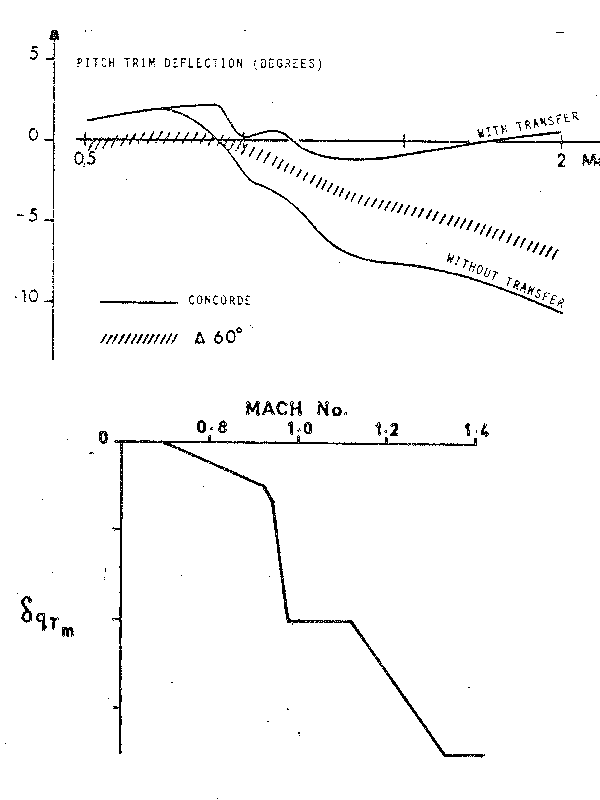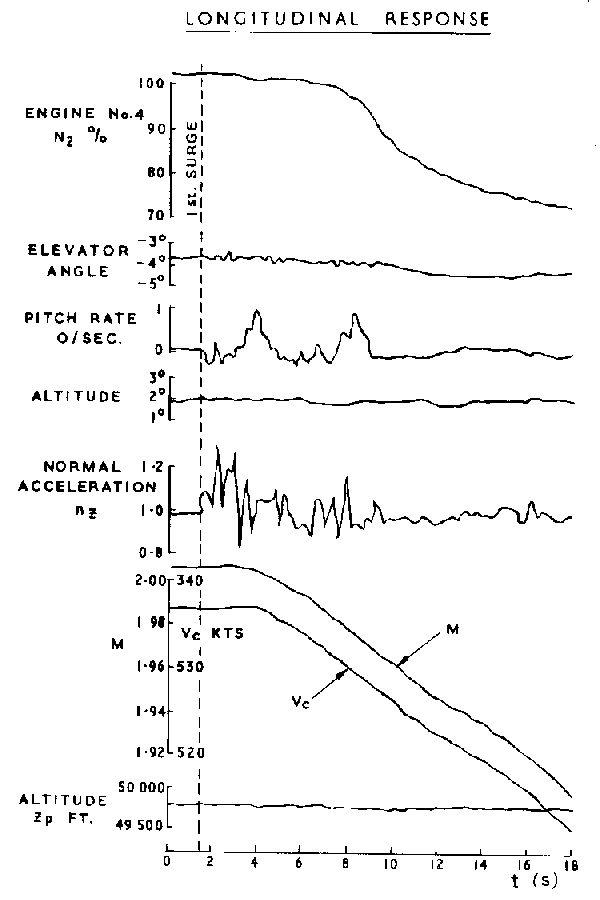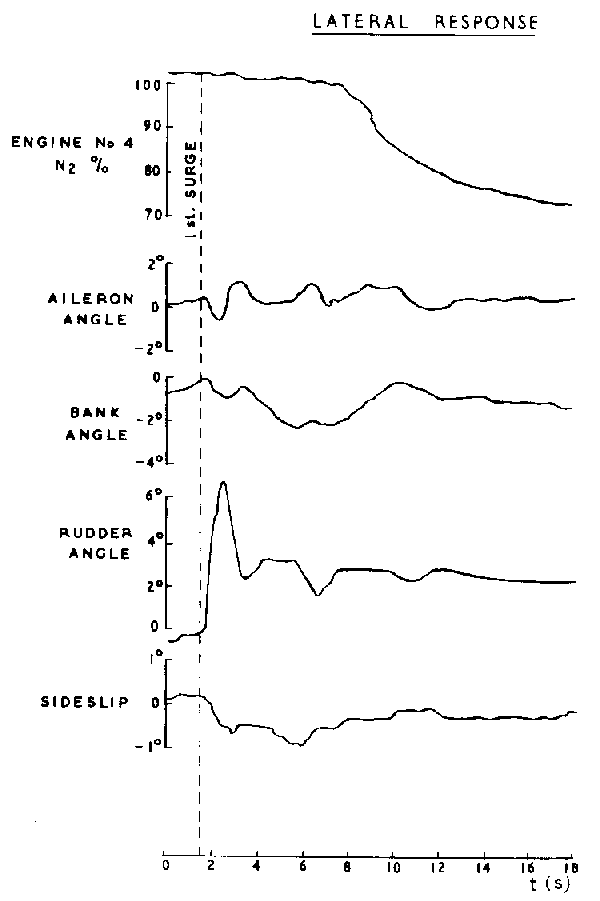19th Aug 2010, 00:22
permalink Post: 23
Biggles78
I must admit, it seems excessive carrying 10,000kg in a trim tank, but this fuel system really was a study in elegance. Every single drop of fuel carried was usable by the engines, and the Mach Trimming was so good that you could fine-tune the process so as to achieve the minimum drag configuration for the aircraft of 1/2 degree down elevon in supersonic cruise. One rather amusing point about the fuel Mach trimming; the airworthiness authorities insisted that the aircraft also had a conventional Mach trimmer built into the electric pitch trim system. As the aircraft was mostly flown on autopliot, assuming the fuel trimming was being done correctly (it always was), the auto-trim would wind off this Mach trimming as it was applied, the net result of course being no change to the pitch demand. This really was a totally superfluous addition to the electric trim system. (If for any reason the aircraft HAD been hand flown during acceleration, the pilot would have to nudge the trim button nose down all the time as the A/C accelerated, in order to to oppose the nose up electric trim input).
The fuel, apart from 'lighting the fires' and trimming the aircraft was also used as a cooling medium for engine and IDG oil, as well as for the hydraulic system also. Where it was used to massive effect, was as a cooling medium for the air conditioning system. Here, at Mach 2 conditions, we needed air to exit the 'packs' (on Concorde these were called 'groups') at around -25 deg's C. By the time this air had travelled through the wing ducting it had risen to a sweltering 0 deg's C, at which temperature it entered the cabin. The astonishing thing is, that the air used for this, HP compressor delivery air, P3, was at around 550 deg's C as it left the engine. The ram air itself, used to cool the Primary and Secondary heat exchangers, had a total temperature anything up to 127 deg's C, and to complete this story, the fuel itself had an average temperature of around 60 deg's C. And surprisingly enough, it was a more or less conventional air conditioning system, using air/air intercoolers, an air cycle machine, with just the addition of the fuel exchanger (between the outlet of the secondary heat exchanger and the ACM turbine) to make it any different in concept to most other air cond' systems.
I must admit, it seems excessive carrying 10,000kg in a trim tank, but this fuel system really was a study in elegance. Every single drop of fuel carried was usable by the engines, and the Mach Trimming was so good that you could fine-tune the process so as to achieve the minimum drag configuration for the aircraft of 1/2 degree down elevon in supersonic cruise. One rather amusing point about the fuel Mach trimming; the airworthiness authorities insisted that the aircraft also had a conventional Mach trimmer built into the electric pitch trim system. As the aircraft was mostly flown on autopliot, assuming the fuel trimming was being done correctly (it always was), the auto-trim would wind off this Mach trimming as it was applied, the net result of course being no change to the pitch demand. This really was a totally superfluous addition to the electric trim system. (If for any reason the aircraft HAD been hand flown during acceleration, the pilot would have to nudge the trim button nose down all the time as the A/C accelerated, in order to to oppose the nose up electric trim input).
The fuel, apart from 'lighting the fires' and trimming the aircraft was also used as a cooling medium for engine and IDG oil, as well as for the hydraulic system also. Where it was used to massive effect, was as a cooling medium for the air conditioning system. Here, at Mach 2 conditions, we needed air to exit the 'packs' (on Concorde these were called 'groups') at around -25 deg's C. By the time this air had travelled through the wing ducting it had risen to a sweltering 0 deg's C, at which temperature it entered the cabin. The astonishing thing is, that the air used for this, HP compressor delivery air, P3, was at around 550 deg's C as it left the engine. The ram air itself, used to cool the Primary and Secondary heat exchangers, had a total temperature anything up to 127 deg's C, and to complete this story, the fuel itself had an average temperature of around 60 deg's C. And surprisingly enough, it was a more or less conventional air conditioning system, using air/air intercoolers, an air cycle machine, with just the addition of the fuel exchanger (between the outlet of the secondary heat exchanger and the ACM turbine) to make it any different in concept to most other air cond' systems.
28th Sep 2010, 22:07
permalink Post: 488
EXWOK
This is the Mach Trimming that was incorporated into the Electric Trom Computers for certification purposes, that I mentioned in a post here about a million years ago (same thread though). With the CG being controlled correctly you'd always notice it of course when you were hand flying, and would get a sore thumb winding the trim down to fight off the nose up Mach trim demand.
And you a steely eyed supersonic jet pilot too

Dude
Quote:
| It was a delight to hand fly supersonic. With autostabs working it was a pleasure to fly through the whole regime, although from M0.95 to about M1.3 it was a bit squirmy - as though someone kept playing with the trims. |
Quote:
| PS pls excuse all the shpelling mishtooks - am using a tiny touchscreen keyboard..... |

Dude

Last edited by M2dude; 28th Sep 2010 at 22:29 .
29th Sep 2010, 14:30
permalink Post: 495
A memory which really stuck re. hand flying supersonic was how solid it felt - and how the extreme TAS (about 1200kts) vividly demonstrated the relationship between TAS / angle of bank and turn rate: you rolled on 15 degrees of bank and it seemed like the HSI heading reference had stuck - it just didn't turn. From memory turn radius with 30 degrees AOB at M2 was about 50nms...
Re the autostabs: it felt like the puppet's strings were cut with them off, but switching to Mechanical Signalling as well made it truly horrible. I only ever flew the sim in this config, I understood they used to do it at base but stopped it because they feared lives would be lost. A pal once memorably described it as like trying to fly a dustbin lid around. And so it was! Plug it all back in (Electrical Signalling and Autostabs) and it all snapped back into shape beautifully. So ahead of its time...
There were no doubt pitch trim changes transonic due to the mach trim system, but a more obvious effect in the 0.99-1.3 range was due to shockwaves forming and fading assymetrically causing minor oscillations in all axes: if you watched out front while hand flying the accel or decel you could make out the nose descibing what felt like figures of eight as the trim changed in pitch and yaw. Roll too, and gentle pressure was required on the cc to avoid overcontrolling and PIO - a bigger problem with the Conc than some other types...
Memory lane - this is fun!
Re the autostabs: it felt like the puppet's strings were cut with them off, but switching to Mechanical Signalling as well made it truly horrible. I only ever flew the sim in this config, I understood they used to do it at base but stopped it because they feared lives would be lost. A pal once memorably described it as like trying to fly a dustbin lid around. And so it was! Plug it all back in (Electrical Signalling and Autostabs) and it all snapped back into shape beautifully. So ahead of its time...
There were no doubt pitch trim changes transonic due to the mach trim system, but a more obvious effect in the 0.99-1.3 range was due to shockwaves forming and fading assymetrically causing minor oscillations in all axes: if you watched out front while hand flying the accel or decel you could make out the nose descibing what felt like figures of eight as the trim changed in pitch and yaw. Roll too, and gentle pressure was required on the cc to avoid overcontrolling and PIO - a bigger problem with the Conc than some other types...
Memory lane - this is fun!
21st Dec 2010, 11:19
permalink Post: 912
quote:Re the autotrim, tell us some more?unquote
It is a little complicated, but let me go back half a step.
Concorde was not certificated to FARs or BCAR (the French code was essentially a straight translation of FAR) but to completely new set of requirements known as TSS (Transport Supersonique Standards). The old UK ARB had initiated discussions about these even before cooperation negotiations had started. The result was that young, junior engineers got to debate the basics of airworthiness rules with older, experienced airworthiness specialists. In hindsight it was wonderful training!
But to get to the point, it was this thinking that allowed us to ignore some of the older rules which, although great for the aircraft flying at the time they were written, had little or no relevance to SSTs. We could interpret that as trying to find out what the pilots really wanted the aircraft to do and then to try and provide it.
In the particular case of trim/speed stability it was quite clear that what they wanted was an aircraft that could be flown with minimal trim changes and which once trimmed would not go wandering off all over the place. We also knew that in some cases the 'elevator angle per 'g' ' could get as low as one degree/g in some cases and that the pilot could not tell exactly where his hands were positioned to that precision, although he would always know if he was pushing or pulling. So we could abandon the old rules for stick movement and instead supply classic stick force stability for deviations from the trimmed state.
All this had to be matched to the varying aerodynamics through the transonic region (where everything varies rapidly) and the fuel transfer system characteristics. The resulting Mach trim laws were quite complex and were not, in fact just Mach Number sensitive. We also had two airspeed (Vcas) terms, one of which had a variable gain which was itself Mach dependent and kicked in above Vmo = 5kts and the other was a straight nose up elevator command as a function of Vcas. The Mach trim itself was highly nonlinear. The best way to illustrate this is probably a diagram but now I've run into another gap in my knowledge of this thread - how do I do that?
Anyway, the result was that the fuel transfer held the trim setting variation down to between 2 deg down to 1.5 deg up through the acceleration from 0.95M up to 0.5 deg down at Mach 2.0. Without fuel transfer the trim at Mach 2 would have been closer to 10 deg. The trim between say 0.95 and 1.2 varies in a nonlinear fashion and the Mach trim law shows roughly similar variations.
But the best measure of our success is the comments we are getting here from the guys who actually had to fly it.
Clive
[IMG]file:///C:/Users/Clive/AppData/Local/Temp/moz-screenshot.png[/IMG][IMG]file:///C:/Users/Clive/AppData/Local/Temp/moz-screenshot-1.png[/IMG]
It is a little complicated, but let me go back half a step.
Concorde was not certificated to FARs or BCAR (the French code was essentially a straight translation of FAR) but to completely new set of requirements known as TSS (Transport Supersonique Standards). The old UK ARB had initiated discussions about these even before cooperation negotiations had started. The result was that young, junior engineers got to debate the basics of airworthiness rules with older, experienced airworthiness specialists. In hindsight it was wonderful training!
But to get to the point, it was this thinking that allowed us to ignore some of the older rules which, although great for the aircraft flying at the time they were written, had little or no relevance to SSTs. We could interpret that as trying to find out what the pilots really wanted the aircraft to do and then to try and provide it.
In the particular case of trim/speed stability it was quite clear that what they wanted was an aircraft that could be flown with minimal trim changes and which once trimmed would not go wandering off all over the place. We also knew that in some cases the 'elevator angle per 'g' ' could get as low as one degree/g in some cases and that the pilot could not tell exactly where his hands were positioned to that precision, although he would always know if he was pushing or pulling. So we could abandon the old rules for stick movement and instead supply classic stick force stability for deviations from the trimmed state.
All this had to be matched to the varying aerodynamics through the transonic region (where everything varies rapidly) and the fuel transfer system characteristics. The resulting Mach trim laws were quite complex and were not, in fact just Mach Number sensitive. We also had two airspeed (Vcas) terms, one of which had a variable gain which was itself Mach dependent and kicked in above Vmo = 5kts and the other was a straight nose up elevator command as a function of Vcas. The Mach trim itself was highly nonlinear. The best way to illustrate this is probably a diagram but now I've run into another gap in my knowledge of this thread - how do I do that?
Anyway, the result was that the fuel transfer held the trim setting variation down to between 2 deg down to 1.5 deg up through the acceleration from 0.95M up to 0.5 deg down at Mach 2.0. Without fuel transfer the trim at Mach 2 would have been closer to 10 deg. The trim between say 0.95 and 1.2 varies in a nonlinear fashion and the Mach trim law shows roughly similar variations.
But the best measure of our success is the comments we are getting here from the guys who actually had to fly it.
Clive
[IMG]file:///C:/Users/Clive/AppData/Local/Temp/moz-screenshot.png[/IMG][IMG]file:///C:/Users/Clive/AppData/Local/Temp/moz-screenshot-1.png[/IMG]
21st Dec 2010, 20:20
permalink Post: 933
Here are the graphs that
CliveL
was referring to.
The Mach trim control law

The aircraft response to a double engine surge
Split into two halves (longitudinal and lateral response)


Note the almost immediate rudder response, long before the engine N2 rpm starts to wind down. I'll have something to say about that in a separate post....
CJ
The Mach trim control law

The aircraft response to a double engine surge
Split into two halves (longitudinal and lateral response)


Note the almost immediate rudder response, long before the engine N2 rpm starts to wind down. I'll have something to say about that in a separate post....
CJ
22nd Dec 2010, 20:13
permalink Post: 950
Quote:
|
Originally Posted by
exwok
Hazy recollection - effectively an additional autostabilisation input in the nosedown sense active at high alpha/low EAS.
Ultimately applied a further nose down elevon input (4 degrees????) if EAS was less than (140kts???? That's a VERY low speed). (Colloquially known as 'super-duper stab' on my course) |
To cover this case the 'superautostabiliser'was developed. It effectively restricts the rate of variation of incidence so that, if the pilot entered into an avoidance manoeuvre of sufficient magnitude to trigger the stick wobbler, i.e. about 1.5g, he would be able to recover easily without exceeding the maximum incidence demonstrated in flight (which was in fact slightly greater than the maximum steady incidence limit). This superautostab had gain scheduled against AoA and also included phase advanced pitch rate and speed terms. Finally, there was a 'yaw superautostabiliser which applied rudder as a function of lateral acceleration to restrict sideslip which (see below) could affect the maximum lift attainable. [Note that because of the dynamics of slender aircraft operating at high AoA it was readily possible to develop sideslip in a turn]
Hope that is clear.
Whilst talking about maximum lift etc. can I confirm the numbers quoted in an earlier posting for the start of vortex lift - about 6 or 7 deg AoA at low speed, and for the AoA at maximum lift - about 23 deg. This is where the pitching momemt curve vs AoA 'breaks'. It is not a stall in the conventional sense because of course the flow over the leading edge has been separated long ago. Instead it is the AoA at which the LE vortices become 'too big for their boots' and go unstable and 'burst'. This AoA is sensitive to sideslip and the leading wing half will go first.
CliveL